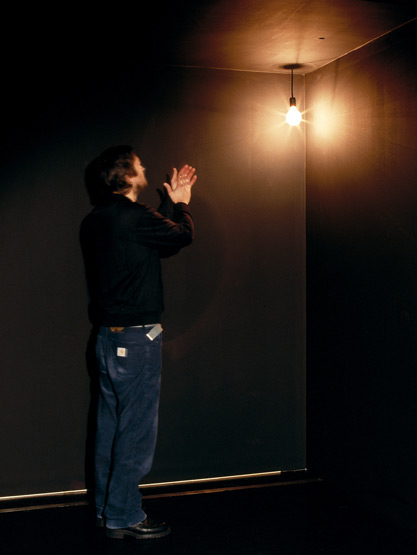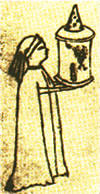This piece Yoko Ono did with Fluxus relates very directly to mine because we use the same medium (video) to look at the striking and burning of a match. I would say that Yoko Ono's piece is far more minimalistic in its exploration while mine takes on a spatial component and the surrounding darkness, which I personally think is an important part of the human component tied to matches.
2. Yaacov Agam-Fiat Lux, 1967
Yaccov Agam likes to work with motion, sound and light. This piece is a lightbulb that turns on because of sound. I feel like the setting and singular light source relates to my piece. Matches produce a sound when lit and Agam is associating light with a sound as well as a space. I found this piece in the Light Art from Artificial Light book I checked out from the Dude.

3. Seth Riskin-Light Dances
Seth Riskin uses dance and light to show space in his works. His work is as much about the darkness as it is about the light source and human interaction. I am actually really excited that I discovered him because his artist statement (quoted below) reveals that we think in similar ways about light and space and movement.




"My first impulse as an artist was to become space. I wanted to bring viewers inside the movement experience, into contact with the numinous dimensions of space. Light allows me to realize this artistic vision.
In the Light Dance performances, light carries the subjective experience of movement beyond the limits of my body. Light Dance is a transposition of the “dance” from the body to the boundaries of the room. In silent, space-defining performances, light effects extend from my body. I “sculpt” space; precise body movements articulate fluid architectures of light, encompassing viewers with the “dance”.
Fundamental tenets of the Light Dance thesis include the concept that inner light and physical light are one, and that an experience of light can overcome the experience of body.
The silence of Light Dance I experience as wholeness. Inspired by a sense of the unlimited, I was led to light as a metaphor for deep knowing, dissolving borders between the body and space, the human spirit and material, the performer and viewer. I understand silence as I do darkness: not void, but whole, the fullest knowing of light, rather than its absence, that may be infinitely articulated and approached through art."
4. Plato's Allegory of the Cave
In his allegory Plato describes people chained to the wall in a cave. Behind them a fire burns and there are puppeteers making shadows. The people fear the shadows because they don't see what causes them. This is all they know of as reality.
I think this relates to my piece because the only light comes from the matches, which create shadows and reveal the world to the performer and audience at the same time. The performer and the camera become puppeteers, deciding what the viewer gets to see within the space at any given moment. Video uses a singular perspective, creating the only reality of my basement that the audience can know.

5. 15th Century Projector-Johannes de Fontana
The projector was initially invented in 1420 by Johannes de Fontana. He drew a picture (seen below) of a monk holding a lantern with a translucent window containing the image of a devil. Most of the initial projections were frightening and related to hell. I think the darkness and flickering shadows of candles and match light can take on that ambiance and they project shadows into a space, even if they are soft and out of focus (which is what Fontana's image would have looked like since his projector didn't have a lens).

No comments:
Post a Comment